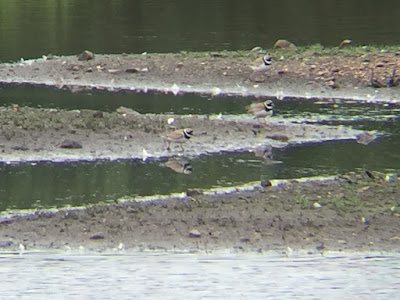As per the last post, little egrets and kingfishers assembled outside the hide suggested that there were masses of fish and inverts in there; So the question was when to offer them up for dinner. Traditionally the 15th of August is always the peak passage time, but the weather prior was not conducive with a wave of barren westerlies. However the 15th saw the wind change to migrant laden easterlies - so mud exposed we awaited the result.
First and best was perhaps the pectoral sandpiper which arrived on the 16th. Generally considered as a trans-atlantic vagrant there is also a sizeable population in northern Siberia, and given there were another 4 in the country all on the east coast it would seem that this was perhaps an Asian bird. It did much better than the preceding 2010 bird which only lasted 10 minutes before being eaten by a sparrowhawk, and remained until the 21st of August giving some good views and ticks for regulars - Steve Hines:
Roy Vincent:
Its near immediate replacement was a little stint which arrived on the 24th of August on north lagoon and remained until the 28th of August. Showing a few feet away it gave some great views - Roy Vincent (stint top - dunlin left, curlew sand bottom):Dwarfed by a moorhen:
Ruff (centre) - Roy Vincent:
Curlew sandpiper:
And perhaps even a grey wagtail!:
Spanning the two birds were up to 4 curlew sandpipers on August the 20th which remained in dwindling numbers until the last left on the 27th of August.
Roy Vincent:
Comparison with a ruff:
Most prevalent amongst the rest were ruff; Still present in good numbers there have been anything up to 17 daily on the lagoon:2 - 3 greenshank have also been constant - Roy Vincent:
With up to 6 green sandpiper, common sandpiper and 170+ lapwing - Roy:
And a few snipe - Roy:
And the odd little ringed plover with 8 dropping in on the 28th out the rain:
A few black tailed godwits, curlew, redshank and the odd whimbrel over. Still little egrets ever present - Roy Vincent:
Otherwise in lieu of a reduced number of little egrets have been kingfishers - seemingly on every water body going including rather optimistically on the 3 week old new woodland pond. Excellent photos again - Phil Dodd:
Steve Hines:
Roy Vincent:
Otherwise pintail passing through, garganey moving off, with a lingering female scaup on D res and a seasonal dispersal green woodpecker around the southern reserve were additional interest. Not to mention masses of wagtails of all flavours roosting on the lagoons - with the terrapin beneath - Steve Hines:
Generally wader numbers drop off into September - but never say never... Likewise butterflies. The best may be over but sunny days are still brining a nice selection out as per Martin Dove:
And always nice to see one of these elusive beasties; water shrew captured pinching flies from spider webs by Pat Hogarth:
Not so welcome has been the return of mink to the reserve - one removed but another still at large.
Unfortunately made worse by the loss of a highly valued member of the Tophill volunteering team recently. Chris Earl has been our star man for controlling mink, along with being a friendly face for visitors over the last few years and sadly passed away after a short illness. He'll be greatly missed and should anyone wish to pay their respects his service will be at Haltemprice Crematorium at 10:30am this Thursday the 1st of September.
Reserve walk this weekend on the 3rd of September at 10am - free with standard admission.
Unfortunately August's bat walk had to be cancelled due to torrential rain that night. As such it has been rescheduled for the 8th of September at 8pm - book on 01377 270690 for places - still a few left. Likewise on the 11th of September we have our 'See a kingfisher' event - again book in advance and hopefully a good chance this year...





































